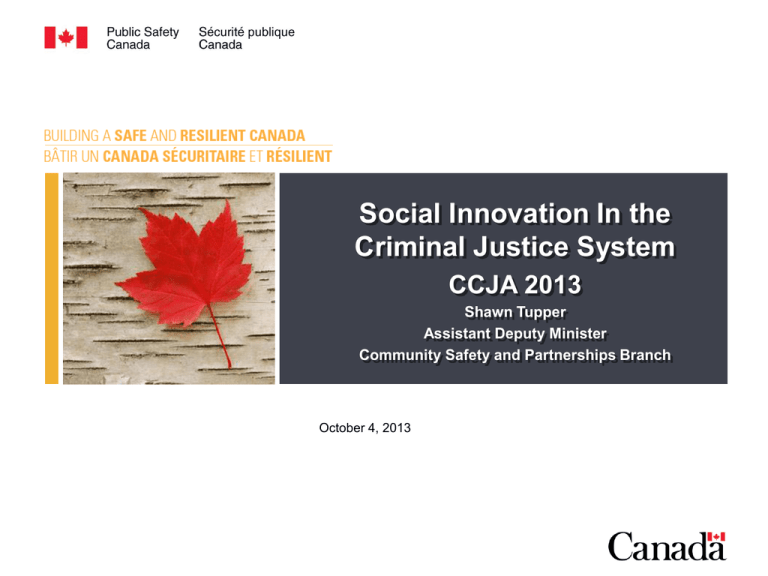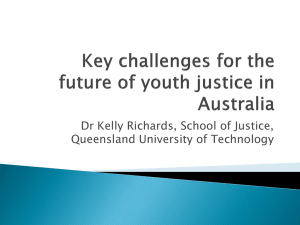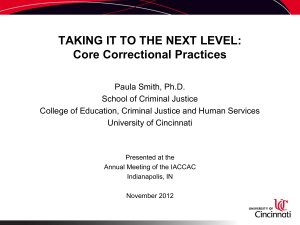See the PowerPoint Presentation
advertisement

Social Innovation In the Criminal Justice System CCJA 2013 Shawn Tupper Assistant Deputy Minister Community Safety and Partnerships Branch October 4, 2013 Overview ● The Economics of Public Safety o The Costs of the Criminal Justice System o The Story of Tyler o The Cost - Benefit of Rehabilitation and Treatment ● ● Addressing Social Issues through Partnerships and Innovation An Exciting Approach - Social Innovation: o The End Goal of Sustainability and Our roles o Challenges And Opportunities o A Criminal Justice Lens o Activities at Public Safety Canada ● The Path Ahead 1 The Economics of Public Safety : The Costs of the Criminal Justice System ● Canadian CJS: $11B+ annually ● Penitentiary system: $2.2B annually ● $100M in community (5%) ● High-risk offenders in Canada cost society upwards of $1.4M per case. 2 The Story of Tyler: Who is Tyler? A fictional character based on the prototypical chronic young offender in Canada. The story of Tyler’s career is intended to illustrate the risk factors associated with a criminal career, the high costs* associated with chronic offending and how those costs can be avoided if the proper interventions are in place. The High Costs of an Offending Pathway NO INTERVENTION INTERVENTION Age 15 Eg. MST (cost = $4,500) • 25 to 70% reductions in long-term rates of arrest The numbers: • 125,000 youth were accused of a Criminal Code offence in 2012 • 55,000 youth were formally charged (or recommended for charging) • 5,500 CJS involved youth become serious, chronic offenders At a cost of $1.5 million each, collectively these serious, chronic offenders would cost Canada over $8.3 billion. * Cost estimates in this scenario only include the tangible costs of crime for the criminal justice system, health care system, and social services. Therefore, the estimate of the total cost of Tyler’s criminal career is likely undervalued. INTERVENTION Age 11 Eg. YIP (cost = $5,500) • 65% reduction in arrests for youth at greatest risk INTERVENTION Age 6 Eg. SNAP® (cost = $5,800) • 60% of high-risk participants did not have a criminal record by the age of 18 3 The Cost – Benefit of Rehabilitation and Treatment ● Rehabilitation Programs produce a NET gain of $10,524 per participant. ● On average, rehabilitation programs reduced recidivism rates by 6%. ● Cognitive-Behavioural therapy (CBT; in groups), costs $217 per participant; benefits of reduced recidivism total $2,588 to taxpayers (lower criminal justice costs) and $8,153 to crime victims (reduced victimization). ● Risk: approximately 1% of Programs such as electronic monitoring and surveillance-oriented programs show the lowest impact on recidivism and costbenefits and even lose money: - Analysis based on 36 outcome evaluations from the United States, Canada and UK Source: Aos, S. (October, 2011). Reduce Crime & Save Money: Switching from Lower to Higher Return-on-Investment Programs and Policies. Presentation at the Roundtable on Economic Analysis of Crime Prevention, Ottawa, ON. 4 Addressing Social Issues through Partnerships and Innovation ● Being aware of the costs to the Criminal Justice System and how we can address them through a variety of facets is a solid starting point. ● It has become increasingly clear that the Government's role can be enhanced through newly framed partnerships. ● Government, Non-Government Organizations, and Private Enterprises are now more than ever, engaged in addressing social issues and a collaborative approach could increase the effectiveness of all our efforts. ● The different facets and players are woven together nicely in the exciting new concept of social innovation. 5 An Exciting approach : Social Innovation ● Social innovations are ideas (products, services and models) that simultaneously meet social needs (more effectively than alternatives) and create new social relationships or collaborations (2010). ● Social innovation is not just about economics but an effective use of fiscal resources that play a role in contributing to the social good. ● The Government of Canada is keen on elevating social innovation as an effective tool to address social issues. Source : (Open Book of Social Innovation, Murray, Calulier-Grice and Mulgan, 2010). 6 Social Innovation : The End Goal of Sustainability and Our roles ● Our aim is to implement effective and efficient social innovation programs that can become sustainable. ● The Federal Government’s role in this area is to encourage and facilitate synergies and work across all levels, Federal, Provincial, Municipal, NGO’s, and private sector to develop best practices. ● There is growing interest of the private sector in financing approaches that create positive social outcomes. ● The innovative expertise of NGO’s can be instrumental in improving outcomes. 7 Social Innovation : Challenges And Opportunities ● As Social Innovation is a relatively untested concept at the national level, it can be quite challenging to get all partners involved. ● Governments are not the experts in this area. ● While there are challenges, the Government encourages increased consultation that will benefit all involved. ● There needs to be a high degree of trust between all partners if we want to think innovatively and ensure that we can all benefit. 8 Social Innovation : A Criminal Justice Lens ● Our mission in the Community Safety and Partnerships Branch is enhancing public safety, in partnership with communities through effective corrections, crime prevention, and Aboriginal Policing. ● The areas to target when implementing Social Innovation models in the Criminal Justice Domain are: Crime Prevention Reintegration for offenders Aboriginal Community Safety 9 Social Innovation : Reducing pathways to offending and victimization, especially among vulnerable youth Current Activities : Crime Prevention ● Crime prevention is a key component of efforts to address growing pressures on the criminal justice system. ● Addressing the needs of vulnerable populations, such as youth at risk including aboriginals, is key to success. ● The National Crime Prevention Strategy which is in many ways a social innovation program is considering ways to: Enhance the vertical and horizontal integration of preventive interventions Scale up and sustain effective prevention efforts 10 Social Innovation : Supporting Successful Offender Reintegration Current Activities: Offender Reintegration ● The recently renewed MOU between Public Safety (PS), Correctional Service Canada (CSC), and Habitat 4 Humanity Canada (H4HC) sets out the roles and responsibilities of each partner towards the goal of ensuring, where feasible, the participation of offenders on parole or work release at each HFH Canada build site and in each HFH Canada ReStore across Canada. CSC organizes and provides support and supervision to the parolee/work release on each build project and in the ReStore position; HFH Canada trains offenders to work in their operations, and consider longer-term employment of offenders; and PS provides overall oversight of the MOU and monitors it to ensure it remains current and reflective of the roles and responsibilities of the three partners. 11 Social Innovation : Supporting Successful Offender Reintegration Current Activities: Offender Reintegration ● We are supporting the Mennonite Central Committee as they develop a project which engages inmates of the Stony Mountain Institution in the production of jewellery which is sold to support a safe-house for victims of crime. This initiative will test how a prison-based social enterprise of this nature serves reintegration and reconciliation processes. ● In partnership with Correctional Service Canada, Employment and Social Development Canada, and the Elizabeth Fry Society we coordinated a project that provides women ex-offenders in Vancouver with hands-on roofing-materials recycling training. 12 Social Innovation : Enhancing the safety of Aboriginal communities Current Activities : Aboriginal Communities ● We will be hosting two regional workshops in the fall of 2013 on innovation and policing in Aboriginal communities for community representatives and police service providers under the First Nations Policing Program. ● The workshops will build on the Government of Canada’s commitment to improve public safety in First Nation communities by providing an opportunity for community leaders, representatives, and police service providers to learn about, and consider possible uses for innovative approaches to policing and public safety in FN and Inuit communities. 13 Social Innovation : Future Endeavors Future Endeavors • In partnership with John Howard Canada, we are examining offender cooperatives as a correctional social innovation model. The model would provide work programs in prisons that help offenders be accountable, prepare for release and provide revenues for restitution, reintegration or other legal obligations. • Through partnerships we are examining the area of social enterprise where a company’s goal is to provide goods and services while also addressing a social agenda (i.e. coffee shops and catering businesses operated by offenders). This model could be applied to offenders within institutions, on conditional release, or post Warrant Expiry Date. 14 Social Innovation : Future Endeavors Future Endeavors • We are exploring with Correctional Service Canada options that seek innovative ways to involve offenders in work and skill building activities that will lead to marketable employment upon offender release. • We are exploring the potential of a pilot project that would use community college mobile trades training centres to deliver certificate programs in areas of high employment demand to offenders at institutions.. • We will continue to explore and promote innovative initiatives, such as the Prince Albert Police Service Community Mobilization project (HUB Model), within policing models offered under the FNPP. The HUB model takes a collaborative approach to identifying and responding to problems involving numerous service providers, including: law enforcement, social services, health care and the education system. 15 Social Innovation : The Path Ahead The Path Ahead • While some of our work is in the early stages, we will continue reaching out to our partners through the vast array of programs in the branch. • We are all at different starting points and that is understandable as the concept of social innovation is quite new. However, we need to embrace the challenges and opportunities ahead. 16











